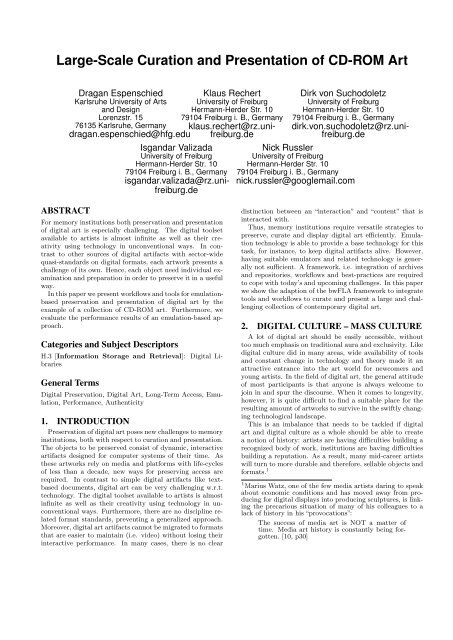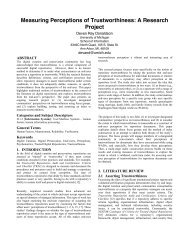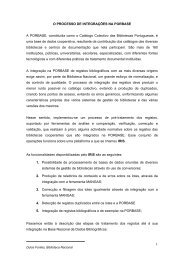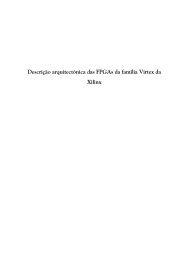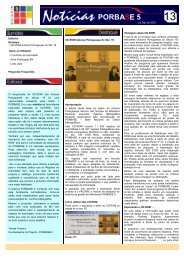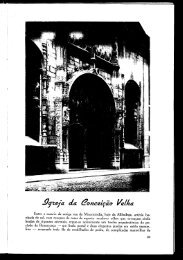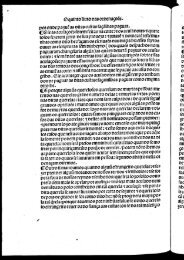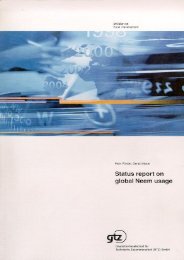Dragan Espenschied, Klaus Rechert, Isgandar Valizada, Dirk Von ...
Dragan Espenschied, Klaus Rechert, Isgandar Valizada, Dirk Von ...
Dragan Espenschied, Klaus Rechert, Isgandar Valizada, Dirk Von ...
Create successful ePaper yourself
Turn your PDF publications into a flip-book with our unique Google optimized e-Paper software.
Large-Scale Curation and Presentation of CD-ROM Art<br />
<strong>Dragan</strong> <strong>Espenschied</strong> <strong>Klaus</strong> <strong>Rechert</strong><br />
Karlsruhe University of Arts University of Freiburg<br />
and Design<br />
Hermann-Herder Str. 10<br />
Lorenzstr. 15<br />
79104 Freiburg i. B., Germany<br />
76135 Karlsruhe, Germany klaus.rechert@rz.unifreiburg.de<br />
dragan.espenschied@hfg.edu<br />
<strong>Isgandar</strong> <strong>Valizada</strong><br />
University of Freiburg<br />
Hermann-Herder Str. 10<br />
79104 Freiburg i. B., Germany<br />
isgandar.valizada@rz.unifreiburg.de<br />
<strong>Dirk</strong> von Suchodoletz<br />
University of Freiburg<br />
Hermann-Herder Str. 10<br />
79104 Freiburg i. B., Germany<br />
dirk.von.suchodoletz@rz.unifreiburg.de<br />
Nick Russler<br />
University of Freiburg<br />
Hermann-Herder Str. 10<br />
79104 Freiburg i. B., Germany<br />
nick.russler@googlemail.com<br />
ABSTRACT<br />
For memory institutions both preservation and presentation<br />
of digital art is especially challenging. The digital toolset<br />
available to artists is almost infinite as well as their creativity<br />
using technology in unconventional ways. In contrast<br />
to other sources of digital artifacts with sector-wide<br />
quasi-standards on digital formats, each artwork presents a<br />
challenge of its own. Hence, each object need individual examination<br />
and preparation in order to preserve it in a useful<br />
way.<br />
In this paper we present workflows and tools for emulationbased<br />
preservation and presentation of digital art by the<br />
example of a collection of CD-ROM art. Furthermore, we<br />
evaluate the performance results of an emulation-based approach.<br />
Categories and Subject Descriptors<br />
H.3 [Information Storage and Retrieval]: Digital Libraries<br />
General Terms<br />
Digital Preservation, Digital Art, Long-Term Access, Emulation,<br />
Performance, Authenticity<br />
1. INTRODUCTION<br />
Preservation of digital art poses new challenges to memory<br />
institutions, both with respect to curation and presentation.<br />
The objects to be preserved consist of dynamic, interactive<br />
artifacts designed for computer systems of their time. As<br />
these artworks rely on media and platforms with life-cycles<br />
of less than a decade, new ways for preserving access are<br />
required. In contrast to simple digital artifacts like textbased<br />
documents, digital art can be very challenging w.r.t.<br />
technology. The digital toolset available to artists is almost<br />
infinite as well as their creativity using technology in unconventional<br />
ways. Furthermore, there are no discipline related<br />
format standards, preventing a generalized approach.<br />
Moreover, digital art artifacts cannot be migrated to formats<br />
that are easier to maintain (i.e. video) without losing their<br />
interactive performance. In many cases, there is no clear<br />
distinction between an “interaction” and “content” that is<br />
interacted with.<br />
Thus, memory institutions require versatile strategies to<br />
preserve, curate and display digital art efficiently. Emulation<br />
technology is able to provide a base technology for this<br />
task, for instance, to keep digital artifacts alive. However,<br />
having suitable emulators and related technology is generally<br />
not sufficient. A framework, i.e. integration of archives<br />
and repositories, workflows and best-practices are required<br />
to cope with today’s and upcoming challenges. In this paper<br />
we show the adaption of the bwFLA framework to integrate<br />
tools and workflows to curate and present a large and challenging<br />
collection of contemporary digital art.<br />
2. DIGITAL CULTURE – MASS CULTURE<br />
A lot of digital art should be easily accessible, without<br />
too much emphasis on traditional aura and exclusivity. Like<br />
digital culture did in many areas, wide availability of tools<br />
and constant change in technology and theory made it an<br />
attractive entrance into the art world for newcomers and<br />
young artists. In the field of digital art, the general attitude<br />
of most participants is that anyone is always welcome to<br />
join in and spur the discourse. When it comes to longevity,<br />
however, it is quite difficult to find a suitable place for the<br />
resulting amount of artworks to survive in the swiftly changing<br />
technological landscape.<br />
This is an imbalance that needs to be tackled if digital<br />
art and digital culture as a whole should be able to create<br />
a notion of history: artists are having difficulties building a<br />
recognized body of work, institutions are having difficulties<br />
building a reputation. As a result, many mid-career artists<br />
will turn to more durable and therefore, sellable objects and<br />
formats. 1<br />
1 Marius Watz, one of the few media artists daring to speak<br />
about economic conditions and has moved away from producing<br />
for digital displays into producing sculptures, is linking<br />
the precarious situation of many of his colleagues to a<br />
lack of history in his “provocations”:<br />
The success of media art is NOT a matter of<br />
time. Media art history is constantly being forgotten.<br />
[10, p30]
Ref. WF-I, FLA Ingest Workflow<br />
OR<br />
Rendering failed / insufficient<br />
VP known / no explicit testing<br />
WF-I.0<br />
WF-I.1<br />
WF-I.2<br />
WF-I.3<br />
WF-I.5<br />
Tech.<br />
Meta-Data<br />
Import dig.<br />
Object<br />
Query for<br />
available VP<br />
OR<br />
Instantiate VP<br />
Obj. Inject &<br />
Rendering<br />
Test<br />
OR<br />
Pack & Output<br />
technical Meta-<br />
Data<br />
WF-I-STMD<br />
Create new VP<br />
VP complete<br />
non SW<br />
Dependecy<br />
Conf.<br />
Required<br />
OR<br />
WF-I.0.b<br />
WF-I.1b<br />
WF-I.4<br />
WF-I.6<br />
Import<br />
Normalization<br />
Select Primary<br />
Rendering<br />
Dependencies<br />
OR<br />
Create<br />
Configuration<br />
Add<br />
User Feedback<br />
Dep. not found<br />
dig. Object<br />
Primary<br />
Rendering<br />
Dependencies<br />
VP<br />
Instance<br />
EXT-A<br />
Ext. Interface to<br />
Access dig.<br />
Object<br />
WF-A-STMD<br />
WF-I-SW<br />
WF-A-SW<br />
Figure 1: bwFLA: Ingest conceptual model.<br />
What is left over of important periods and movements of<br />
digital culture is often no more than printed screenshots in<br />
art books and exhibition catalogues. In some cases, they<br />
are looking good on paper, but access to the actual artifacts<br />
is unavailable. There is no way to actually compare or<br />
re-evaluate these artifacts a second time, discuss their relevance<br />
retrospectively, analyze interactions in between them<br />
or just keep the discussion around them going – and this<br />
quite drastic cultural cut-off happens with objects that are<br />
just a few years old.<br />
A useful and quite promising approach to curate highly<br />
volatile digital art is recognizing it as mass culture, which in<br />
turn requires a mass-curation approach. In this case, mass<br />
doesn’t mean uniformity and is not referring a broadcasting<br />
model of media, but mass authorship and mass prosuming.<br />
This understanding makes it possible to define more abstract<br />
“significant properties” on a large collection of artifacts.<br />
Digital culture is practices rather than artifacts.<br />
No digital artifact, regardless of its manifestation, e.g. as<br />
file, an executable, a memory-dump, or similar, carries a<br />
history within itself. One of the main features of digital data<br />
is that any part of it can be easily changed, re-contextualized<br />
or removed without a trace. Of course, the same applies for<br />
digital art.<br />
Knowledge is mostly embedded in practices. History is<br />
comprehended as the understanding of how and in which<br />
contexts a certain artifact was created and manipulated and<br />
how it affected its users and surrounding objects. For instance,<br />
the process of how a web page is built and the almost<br />
infinite amount of technological environments in which<br />
this artifact can be used (browsers, image manipulation software,<br />
text-editors, word processors, video editors, printers)<br />
for different purposes and with different motivations (rearrangement,<br />
comparison, re-design, plagiarism, collecting,<br />
entertainment) is crucial for understanding and classifying<br />
the artifact.<br />
For a meaningful preserving of such artifacts, this means<br />
that a memory institution needs to provide methods of interaction<br />
and manipulation for its collection. Otherwise it will<br />
be impossible to make sense of them outside of speculation.<br />
Authenticity does not scale.<br />
In theory it might be possible to reconstruct environments<br />
for almost any single digital artifact that re-enacts its performance<br />
exactly “as the artist intended” given suitable (financial)<br />
resources. In general, however, such an approach<br />
is either inefficient, i.e. too laborious for many artifacts, or<br />
it makes no sense because the artist’s specifications cannot<br />
be met technically or logistically. Finally, the whole idea of<br />
individual technical restoration may not match the artifact’s<br />
main performance feature because it unfolds its impact in<br />
mass usage and distribution, and therefore has no “form”<br />
outside of practice.<br />
Since there is no single way to render, view or use a digital<br />
artifact, it is futile attempting to define one. There might<br />
be even no time to read every artist’s statement on how an<br />
artifact should be handled. — The information contained in<br />
“installation instructions” might as well be considered meaningless:<br />
Detailed instructions are typically defined for special<br />
situations like exhibitions, but have no effect on the<br />
artifact’s behavior outside of them. While artists can define<br />
what type of monitor or projection shall be used to display<br />
a work in a museum or gallery, they have no say in how and<br />
when their work is accessed by for example web users, they<br />
cannot even dictate and ephemeral nature of their creation.<br />
Instead, making the largest possible amount of artworks<br />
accessible in combination with providing broadly generalized<br />
forms for their interaction and manipulation, seems like<br />
the most worthwhile approach. The outcome is a reduced<br />
amount of rich simulated environments that enable the interaction<br />
of and with more artifacts.
This is not about disrespecting individual artists, but to<br />
generally enable discussions about certain forms of art and<br />
artists. Hence, in order to create the possibility for artifacts<br />
to reach cultural and historical significance in the first place,<br />
fidelity and ease of access need to be balanced. What “ease<br />
of access” means depends on technology and usage patterns<br />
available at the time of access. In general, the least expert<br />
knowledge is needed to interact with an artifact, the better.<br />
The highest grade of accessibility is the possibility for general<br />
users to be confronted with an artifact and interact with<br />
it in their typical context. Example: screenshots of interactive<br />
works are easy to distribute, post on social media sites,<br />
archive, modify. The accessibility of an re-enactment can<br />
quite easily be asserted, fidelity, though, is an open-ended<br />
scale.<br />
Poetic Qualities of Emulation and Digital Art.<br />
It is meaningful to not only rely on emulation to deliver<br />
a historic performance, but to develop expressive devices<br />
on top of emulation that can serve as building blocks<br />
for environments. Different output devices and some of<br />
their glitches can be staged, their effects combined. For<br />
instance, simulating the image structures of low-resolution<br />
CRT screens on today’s high-resolution LCD screens is a<br />
common technique used in the video game emulation community.<br />
While there are different CRT software emulators<br />
available and some enthusiasts are working to thoroughly<br />
replicate properties of precise monitor models in software,<br />
users are usually free to choose which display mode looks<br />
best for them.<br />
Preservation of digital art must build upon this model<br />
for re-enactments in order to address the infinite context<br />
problem: It might be impossible to deliver the exact performance<br />
of an historic monitor, but a simple CRT fake that<br />
can be switched on at will might enhance the performance of<br />
many artifacts at once. Similarly, it is unfeasible to connect<br />
a snapshot of the whole Internet at a certain point in time<br />
with a historic artifact from that time. Yet, a “good enough”<br />
fake that can mimic popular services up to a certain point<br />
of interaction based on a simple archive can be developed<br />
and provided to enhance the performance of a whole class of<br />
artifacts. It is not even necessary to define these classes in<br />
advance, as an improvement of the framework might affect<br />
an unknown number of artifacts’ performances.<br />
Artifacts that either rely on certain subtleties of their environment<br />
that are hard or impossible to cover via emulation<br />
or staging, or are requiring a context too large to re-create<br />
or stage, are certainly losing some of their quality. Both of<br />
these types of work are actually easy to create for artists.<br />
Once the re-enactment of historic digital art is established<br />
as a task spanning more than one piece, but rather whole<br />
genres, periods and movements, it will be possible to approximate<br />
even these cases to an agreeable quality. Already<br />
before, each working artifact carries the possibility to enhance<br />
the performance of every other artifact.<br />
3. RELATED WORK<br />
Geoffrey Brown and colleagues also tackled the problem<br />
of preserving CD-ROMs as well as providing access by using<br />
an emulation-based strategy [11, 1]. To enable several<br />
institutions making use of and potentially contribute to the<br />
collection, the CD-ROMs are served through a distributed<br />
filesystem. Further, they require some client preparation<br />
regarding emulator setup. Compared to local provisioning<br />
of a complex service stack as also proposed in KEEP [6,<br />
5], a networked approach reduces technical and organizational<br />
hurdles at the client’s side significantly. In contrast,<br />
we present a versatile server-based infrastructure providing<br />
functional access to a wide range of emulators and operating<br />
systems without any requirements regarding the user’s<br />
client environment beside a standard modern web browser.<br />
With respect to authentic preservation and presentation of<br />
complex digital objects, in particular digital art, the discussion<br />
can be divided into a technical and an art-related part.<br />
Guttenbrunner et al. provide a generic framework qualifying<br />
emulator performance [3]. Furthermore, there is a lively discussion<br />
on authentic simulation of individual technical components<br />
such as CRT screen simulation [9, 2]. Following the<br />
discussion above, the goal of the bwFLA framework, but also<br />
the focus of this work, is providing convenient access to current<br />
emulator technology and corresponding digital objects.<br />
By using an emulation-as-a-service architecture model, new<br />
emulators and technology can be integrated with reasonable<br />
effort, being then available for any already present digital<br />
artifact. Regarding the preservation of digital art Perla Innocenti<br />
also pointed out the difficult notion of authenticity<br />
in this context [4]. She introduced the concept of dynamic<br />
authenticity, also proposing a variable approach and objectcentric<br />
approach, allowing a certain degree of tolerance “to<br />
match digital art intrinsic variability.” Similar, in this work<br />
we focus on a pragmatic approach by today’s available emulator<br />
technology.<br />
4. ENVIRONMENT AND TOOLS<br />
The Baden-Württemberg Functional Long-Term Archiving<br />
and Access (bwFLA) is a two-year state funded project<br />
transporting the results of past and ongoing digital preservation<br />
research into practitioners communities. Primarily,<br />
bwFLA creates tools and workflows to ensure long-term access<br />
to digital cultural and scientific assets held by the state’s<br />
university libraries and archives. The project consortium<br />
brings together partners across the state, involving people<br />
from university libraries computing centers, libraries and<br />
archives providing a broad range of background and insights<br />
into the digital preservation landscape.<br />
Workflows and tools developed by the bwFLA project are<br />
designed to be used in a distributed, labor- and cost-sharing<br />
setting. While the project delivers technical solutions and a<br />
distributed service-model, preservation of individual digital<br />
objects and accompanying measures are left to individual<br />
memory institutions. The goal of the bwFLA framework is<br />
to enable these institutions to use tools and perform workflows<br />
on certain types of digital objects, both for ingest and<br />
access workflows.<br />
The bwFLA Emulation-as-a-Service (EaaS) framework and<br />
its abstract workflows have been adapted to a specific domain,<br />
in particular a CD-ROM digital art collection. Technical<br />
background of the emulation framework can be found<br />
in earlier work [8]. This paper focuses on providing tools<br />
and an actual workflow implementation<br />
• to quickly look through a large collection of yet unknown<br />
digital objects,<br />
• to create technical meta-data describing a working rendering<br />
environment,
(a) Ingest Step 1: Selecting a CD from the archive. (b) Ingest Step 2: Rendering and evaluation of a digital<br />
artifact.<br />
Figure 2: bwFLA: Ingest workflow implementation.<br />
• to create meta-data describing content features,<br />
• to organize the collection by creating screenshots and<br />
videos,<br />
For this, the framework provides three basic workflows:<br />
ingest, preparation of rendering environments and access.<br />
In this paper we will discuss ingest and access workflows<br />
in detail, while a detailed description of the environment<br />
preparation workflow is given in earlier work [7].<br />
4.1 Ingest<br />
• to provide a simple access platform for a general audience.<br />
The bwFLA ingest workflow is designed as a flexible and<br />
optional extension of traditional ingest workflows. Therefore,<br />
we assume that basic archival meta-data is already<br />
recorded and available, i.e. due to a previous basic archival<br />
ingest workflow. Similar, we assume that the digital object<br />
is available through some archival identifier and can be<br />
retrieved through a dedicated interface. Starting from the<br />
conceptual model depicted in Fig. 1 a specific workflow instance<br />
to describe CD-ROM artwork has been adapted and<br />
implemented.<br />
As a first step of the emulation ingest workflow, the manifestation<br />
of the digital object is normalized (WF-I.0 esp.<br />
WF-I.0.b). In our case, we have received a CD-ROM collection<br />
containing either a folder consisting of an ISO file<br />
together with a thumbnail image and in some cases a description<br />
or we have received directories containing all CD<br />
items as individual files. For the latter case, ISO files were<br />
created as part of the workflow normalization step.<br />
The user is then able to select an individual object by requesting<br />
a specific archival ID. Additionally available information<br />
from the archival meta-data is displayed as reference.<br />
If this data is incomplete, the user is able to complete the<br />
data-set. To keep the workflow as simple as possible, only<br />
two types of rendering environments are selectable: Apple<br />
Macintosh and Microsoft Windows. The concrete operating<br />
system version is chosen automatically based on the object’s<br />
production year. In case of special requirements, the user is<br />
able to run a system image preparation workflow to create a<br />
specialized rendering environment (denoted as WF-I-SW in<br />
the conceptual model). Fig. 2(a) shows the correspondent<br />
user interface.<br />
At this point, an emulation component has been allocated<br />
and set up and the object has been prepared to be injected<br />
into the rendering environment. With WF-I.3, the second<br />
phase of the ingest process begins with starting the chosen<br />
rendering environment and injection of the digital object.<br />
At this point, the user is required to evaluate the quality of<br />
the object presentation. Next to the emulator output (cf.<br />
Fig. 2(b)), the user is able to describe technical configuration<br />
details (such as optimal screen resolution, color depth<br />
etc.) and the object’s desired/expected as well as the actual<br />
performance in the chosen environment. Gathering this<br />
feedback is used to compile a fidelity rating that is displayed<br />
during access and may help users to interpret imperfect emulation<br />
results or to choose only artifacts that are emulated<br />
in a certain quality. This meta-data set is rather domainspecific<br />
and discussed in detail in Section 5. At this step,<br />
also auxiliary material such as screenshots or video captures,<br />
could be produced, e.g. to enrich catalog records.<br />
As a result of the bwFLA ingest workflow, technical metadata<br />
is created describing both the technical setup, i.e. technical<br />
details rendering the environment’s view path, user<br />
configuration as well as domain specific performance measures.<br />
The data is encapsulated either as JSON object or<br />
XML file and is delivered to the object owner. Archiving<br />
of meta-data as well as the objects are the owner’s responsibilities<br />
since bwFLA only provides the technical framework.<br />
Only a limited set of rendering environments are kept,<br />
to improve usability and access to objects. With the provided<br />
technical meta-data, however, an automatic or semiautomatic<br />
instantiation of a view-path is available as part<br />
of the WF-A-SW workflow [7].<br />
4.2 Access<br />
Having appropriate meta-data, the bwFLA access workflow<br />
provides convenient access to archived digital objects.
(a) Available CD-ROMs.<br />
(b) Digital object rendered in emulated environment.<br />
Figure 3: bwFLA: Functional access to digital art collection.<br />
Similar to the assumptions made at ingest time, we assume<br />
that objects and meta-data are accessible through a dedicated<br />
networked interface. The user is then able to choose an<br />
object from the catalog, browse its meta-information and finally<br />
start the rendering process. Fig. 3(a) shows the current<br />
bwFLA catalog implemented for the Transmediale festival 2<br />
collection. Based on the provided meta-data the requested<br />
environment is instantiated and started with the digital object<br />
attached. Fig. 3(b) shows the rendered result.<br />
5. QUANTITATIVE ANALYSIS<br />
As a test-case, the Transmediale archive kindly provided<br />
us with their collection of CD-ROM art in the form of ISO or<br />
bin image files. Most of the objects were created in between<br />
1995 and 2005, the largest part during the height of the<br />
genre around 1999 and 2001.<br />
The Transmediale’s goal is to make this collection publicly<br />
available online. Since the collection contains 272 pieces, it is<br />
unfeasible to analyze each one in-depth. Instead, a representative<br />
selection of six CD-ROMs was picked out to be evaluated<br />
on original, consumer grade Apple hardware that was<br />
also often used in exhibition settings. This performance was<br />
compared to the performance on a stock emulator. Based on<br />
this analysis, a very limited list of performance properties<br />
was created that only consider the emulator’s performance<br />
over the network and configuration.<br />
Technical requirements like processor speed, amount of<br />
RAM and exact OS version are not very important in the<br />
context of CD-ROM art, and usually available as part of<br />
the provided view-path. If the artist had specified certain<br />
setups, in most of the cases this information turns out to<br />
just be the artist’s own setup used to create the work. Since<br />
most CD-ROM art was created using Macromedia Director<br />
(an integrated authoring software catering to the lowest<br />
technical dominator), great performance issues are not<br />
to be expected. The operating system version to use can<br />
be extrapolated from each CD-ROMs publishing date. For<br />
instance, an exact Quicktime version to replay a video is<br />
even less critical, as Quicktime was sufficiently backwards<br />
2 Transmediale Festival, http://www.transmediale.de/<br />
compatible: newer versions could replay all older versions’<br />
videos. As the Quicktime library was used to embed videos<br />
into Macromedia Director, how the actual player controls<br />
look in different versions is irrelevant because they are never<br />
visible anyway.<br />
Technical features & User configuration.<br />
The first subset of meta-data collected describes objectively<br />
perceptual technical features and user-configuration.<br />
A view-path is able to describe the general technical setup<br />
starting with a detailed description of the emulated hardware<br />
to installed application, fonts and libraries.<br />
However, many visible features of a system environment<br />
depend on individual user-configuration:<br />
• Platform: This property describes a suitable rendering<br />
platform for a digital object. Usually the platform<br />
is named after its backing OS and or hardware.<br />
The description of the rendering platform describes the<br />
combination of a concrete software stack (view-path)<br />
and its specific emulator configuration.<br />
• Network access might be required for an artifact or<br />
may enhance its performance. This property describes<br />
if a network setup is provided by the chosen platform,<br />
i.e. the emulator provides suitable networking features<br />
and the chosen platform is configured properly.<br />
• Vision and Sound: Pixel resolution and color depth<br />
have an impact on the computational performance of<br />
the emulator as well as the infrastructure that is required<br />
to deliver its results to the user. Especially<br />
interactive works can benefit greatly from a possible<br />
reduction of system reaction time. While this property<br />
is a technical feature it is usually only observable<br />
if the specific platform is instantiated.<br />
• Information about animation quality enables to create<br />
an educated compromise setup about interactivity,<br />
pixel resolution and color depth. In some cases, a<br />
smooth movement of on-screen objects is more important<br />
for an artifact’s performance than accurate color
Figure 4: Preliminary results: technical features and user-configuration.<br />
Figure 5: Preliminary results: dramaturgy of presentation.<br />
representation or detail, others might rely more on vibrant<br />
still images. Full screen animation, where each<br />
animation frame replaces the contents of the complete<br />
frame buffer, are especially challenging.<br />
This is an important criterion because the general user<br />
base is very aware of “snappy” versus “sluggish” animation.<br />
Consumer devices have been advertised on the<br />
basis that their reaction times are very low, there are<br />
established terms and language to describe different<br />
rates of performance.<br />
High and low color depths and resolutions are also<br />
easily distinguished by users because low-color, lowresolution<br />
graphics are accepted as form of expression<br />
of its own and are often associated with “old computers”.<br />
Since the collection of CD-ROM Art is explicitly<br />
“old”, a reduction of color depth will be more accepted<br />
by the audience than a loss of animation quality.<br />
• Synchronicity: Are audio and video in any way related<br />
to each other? Some CD-ROMs might have a<br />
sound track that is not in sync with what is visible on<br />
screen, others trigger sound effects to emphasize certain<br />
visual events or interactions. Disconnected audio<br />
loops can be delivered to the user on a side channel,<br />
for example a separately downloadable audio file. The<br />
emulator would not need to take care of sound in this<br />
case at all. In the synchronous case, the sound effects’<br />
bit-depth and sample rate might be needed to<br />
be sacrificed. Since audio is used in so many contexts<br />
(headphones, active and passive speakers of different<br />
quality, mobile phone speakers, etc), users usually cannot<br />
notice or describe the bit depth or general fidelity<br />
of sound without two comparable recordings being replayed.<br />
Well-synced audio and video makes a great user experience<br />
and should always be considered more important<br />
than sample rate, bit depth and color depth.<br />
Dramaturgy.<br />
A sub-set of domain specific meta-data, describing expectations<br />
on the artwork’s general performance and dramaturgy.<br />
• Structuring of time: How a CD-ROM is making use<br />
of dramatic devices over time, can greatly affect the<br />
emulator’s configuration. If the work makes no dramaturgic<br />
reference to the underlying operating system
and does nothing during loading, or even can run as a<br />
loop, the emulator can be set up to launch straight into<br />
the software without presenting any parts of the operating<br />
system to the user. This might greatly reduce<br />
the effort of constructing an emulation environment.<br />
• Interactivity: If the work requires any kind of user<br />
interaction to perform, the emulator has to provide<br />
adequate facilities. If the work is not interactive, there<br />
is no need to provide those.<br />
6. EVALUATION RESULTS<br />
For finding the evaluation criteria, six artifacts were examined<br />
in-depth. At the moment of this writing, the evaluation<br />
on original hardware is still ongoing, 86 of 272 artifacts have<br />
been checked in the course of only a few days.<br />
It was found out that only 5 artifacts make use of a sophisticated<br />
arrangement of icons and windows in the operating<br />
system environment. Only 4 artifacts made use of<br />
a designed intro sequence, 2 artifacts featured a designed<br />
loading sequence. Apart from the operating system’s mouse<br />
pointer images, which were appearing in 44 pieces, no visual<br />
elements of the operating system were used within interactive<br />
pieces. 72 pieces can be considered interactive, 43 have<br />
a beginning and an end, only 13 can run in a loop. 38 run<br />
in full screen and thereby hide the underlying operating system<br />
completely. Figure 4 and 5 visualize evaluated features<br />
of our preliminary results.<br />
The genre of CD-ROM art didn’t seem to be too reflective<br />
of or alluding to its software environment. Ultimately,<br />
it is not even reflective of the CD-ROM and its media specific<br />
properties, like slow loading and read-only data access.<br />
Instead, authors seemed to strive for closed, narrative, interactive<br />
experiences. For the access part, this means that the<br />
boot-up process of the emulated operating system and even<br />
the loading of the CD-ROM’s data can be skipped over and<br />
instead a saved state of the emulator with the work already<br />
fully prepared to be interacted with should be presented to<br />
the user. Witnessing the preparation process should be the<br />
user’s choice at the moment of access. In order to define<br />
a saved state, the ingest process has to provide means of<br />
“freezing” a state of the emulator, in bwFLA this is implemented<br />
with a “save current state” button in the evaluation<br />
GUI.<br />
33 works apply digital video replay, 46 require synchronous<br />
audio and video. In many cases, the sound effects are simple<br />
clicks to re-assure the user of an interaction acknowledged<br />
by the system – however, if these sound effects are delayed,<br />
they can cause a lot of confusion. In these cases, it would<br />
be better to turn off sound in case the emulator or network<br />
infrastructure cannot produce synchronicity. Again, during<br />
access, the user should be presented with the option to turn<br />
off sound.<br />
7. LESSONS LEARNED<br />
While the used emulators themselves (QEMU 3 , Sheep-<br />
Shaver and BasiliskII 4 do not have problems running any<br />
3 Open Source Processor, http://wiki.qemu.org/Main_<br />
Page (version of 6/28/2013)<br />
4 BasiliskII and Sheepshaver, Open Source M68K and Power-<br />
Mac Emulator, http://sheepshaver.cebix.net/ (version<br />
of 6/28/2013)<br />
of the artifacts with adequate performance locally, the networking<br />
layer and standardized browser clients introduced<br />
by the EaaS approach are responsible for the widest variety<br />
in performance. While the networked setup of bwFLA’s<br />
EaaS approach reduces the technical hurdles using emulation<br />
significantly, latency and sound transport issues may<br />
reduce the overall performance results.<br />
As a result, it makes sense to collect single evaluation<br />
results per artifact from tests on original hardware and multiple<br />
evaluation results per artifact from tests on the emulator.<br />
The single tests on original hardware are mainly<br />
serving the purpose to define what properties are to be expected<br />
and should be checked later in the emulator. The<br />
multiple evaluation results per artifact contain performance<br />
connected together with certain values describing the state<br />
of the emulator and the client at runtime (emulator setup,<br />
load of the emulation host, network throughput, network<br />
delay, load of the client, etc). This allows to compare different<br />
setups and create an estimation of fidelity for future<br />
runs, to point users’ attention to properties that might not<br />
perform quite as they should. Users then can adjust their<br />
expectations and perception of the artifact’s performance,<br />
leading to more conscious interpretations. Multiple evaluations<br />
also open up the possibility of a community-based<br />
evaluation, where users with knowledge of a certain detail<br />
in the original performance can give feedback on how well<br />
the emulator performance matches, or can create different,<br />
alternative EaaS set-ups that improve a certain aspect or all<br />
of the performance of an artifact.<br />
During evaluation of the emulator’s performance, it has<br />
proven more practical to ask the user only to check for failures<br />
of the system, as they are more apparent to identify:<br />
jerky animation due to network latency is obvious to spot,<br />
manually running through lists of always the same properties<br />
that apparently work fine and confirming each seems<br />
like a waste of time.<br />
8. DISCUSSION & CONCLUSION<br />
Digital art is a new challenge for memory institutions and<br />
galleries, which is different from traditional art forms, even<br />
from the newer developments like video art. Simple screenshots<br />
or video recordings cannot capture all object properties.<br />
The presented method supports preservation of digital<br />
art, especially for object appraisal and curation. The<br />
method can be easily extended to other uses, like the presentation<br />
of non-standard, interactive artifacts in libraries.<br />
The same applies for the cataloging and curation of a wide<br />
range of computer games and can be the tool of choice to<br />
sift through software archives.<br />
Some issues, however, remain open at this point. Most<br />
urgently, licensing, especially with regards to distributed architectures<br />
such as bwFLA’s EaaS model, is a huge hurdle.<br />
While such a model contributes to usability and enables<br />
access to digital art for a wide audience, the legal situation<br />
especially, regarding operating system and software,<br />
needs more attention, since this leads to a paradox situation.<br />
While ancient operating systems and software packages have<br />
lost most probably their commercial value as well as their<br />
functional utility, digital art most probably increases its cultural<br />
level with time progressing.
Acknowledgments<br />
The work presented in this publication is a part of the bwFLA<br />
– Functional Long-Term Access 5 project sponsored by the<br />
federal state of Baden-Württemberg, Germany.<br />
9. REFERENCES<br />
[1] G. Brown. Developing virtual cd-rom collections: The<br />
voyager company publications. International Journal<br />
of Digital Curation, 7(2):3–22, 2012.<br />
[2] M. Guttenbrunner and A. Rauber. Re-awakening the<br />
philips videopac: From an old tape to a vintage feeling<br />
on a modern screen. In Proceedings of the 8th<br />
International Conference on Preservation of Digital<br />
Objects (iPres 2011), pages 250–251, 11 2011.<br />
Posterpresentation: iPres 2011 - 8th International<br />
Conference on Preservation of Digital Objects.<br />
[3] M. Guttenbrunner and A. Rauber. A measurement<br />
framework for evaluating emulators for digital<br />
preservation. ACM Trans. Inf. Syst., 30(2):14:1–14:28,<br />
May 2012.<br />
[4] P. Innocenti. Rethinking authenticity in digital art<br />
preservation. In 9th International Conference on<br />
Preservation of Digital Objects (iPRES2012), pages<br />
63–67. University of Toronto, 2012.<br />
[5] B. Lohman, B. Kiers, D. Michel, and J. van der<br />
Hoeven. Emulation as a business solution: The<br />
emulation framework. In 8th International Conference<br />
on Preservation of Digital Objects (iPRES2011), pages<br />
425–428. National Library Board Singapore and<br />
Nanyang Technology University, 2011.<br />
[6] D. Pinchbeck, D. Anderson, J. Delve, G. Alemu,<br />
A. Ciuffreda, and A. Lange. Emulation as a strategy<br />
for the preservation of games: the keep project. In<br />
DiGRA 2009 – Breaking New Ground: Innovation in<br />
Games, Play, Practice and Theory, 2009.<br />
[7] K. <strong>Rechert</strong>, I. <strong>Valizada</strong>, and D. von Suchodoletz.<br />
Future-proof preservation of complex software<br />
environments. In Proceedings of the 9th International<br />
Conference on Preservation of Digital Objects<br />
(iPRES2012), pages 179–183. University of Toronto<br />
Faculty of Information, 2012.<br />
[8] K. <strong>Rechert</strong>, I. <strong>Valizada</strong>, D. von Suchodoletz, and<br />
J. Latocha. bwFLA – a functional approach to digital<br />
preservation. PIK – Praxis der<br />
Informationsverarbeitung und Kommunikation,<br />
35(4):259–267, 2012.<br />
[9] J. Scott. What a wonder is a terrible monitor. Online<br />
http://ascii.textfiles.com/archives/3786, 2012.<br />
[10] M. Watz. The futility of media art in a contemporary<br />
art world. Online<br />
http://www.scribd.com/doc/110282792/<br />
20121015-LISA-The-Futility-of-Media-Art-in-a-\<br />
Contemporary-Art-World, Oct 2012.<br />
[11] K. Woods and G. Brown. Assisted emulation for<br />
legacy executables. International Journal of Digital<br />
Curation, 5(1), 2010.<br />
5 bwFLA – Functional Long-Term Access, http://bw-fla.<br />
uni-freiburg.de.


